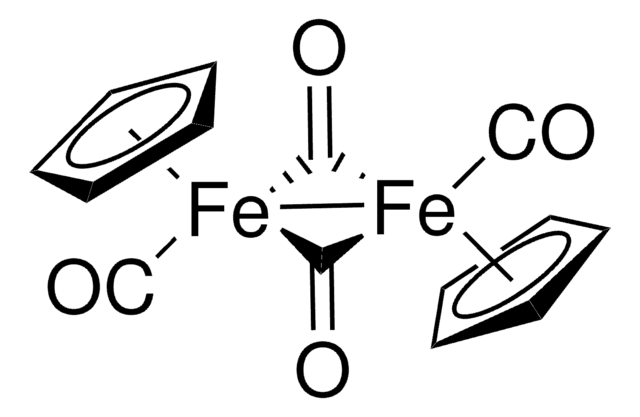195731
Iron(0) pentacarbonyl
Synonym(s):
Iron(0) carbonyl, Pentacarbonyliron(0)
About This Item
Recommended Products
vapor density
6.74 (vs air)
Quality Level
vapor pressure
35 mmHg ( 25 °C)
40 mmHg ( 30.3 °C)
autoignition temp.
122 °F
reaction suitability
core: iron
reagent type: catalyst
greener alternative product characteristics
Catalysis
Learn more about the Principles of Green Chemistry.
sustainability
Greener Alternative Product
refractive index
n20/D 1.5196 (lit.)
bp
103 °C (lit.)
mp
−20 °C (lit.)
density
1.49 g/mL at 25 °C (lit.)
greener alternative category
, Aligned
storage temp.
2-8°C
SMILES string
[Fe].[C-]#[O+].[C-]#[O+].[C-]#[O+].[C-]#[O+].[C-]#[O+]
InChI
1S/5CO.Fe/c5*1-2;
InChI key
FYOFOKCECDGJBF-UHFFFAOYSA-N
Looking for similar products? Visit Product Comparison Guide
General description
Application
- As an iron source to synthesize Fe-doped thin TiO2 films.
- As a ligand to synthesize complexes of gold(I) and Fe(CO)5, silver and Fe(CO)5.
- Addition reactions
- Decomposition via photolysis
- Preparation of magnetic Fe onion-like fullerene micrometer-sized particles of narrow size distribution via thermal decomposition
- Preparation of a heptanuclear iron carbonyl cluster used in catalytic hydrosilane reduction of carboxamides
- Precursor for preparation of Fe nanoparticles for photocatalytic hydrogen evolution under highly basic conditions
Signal Word
Danger
Hazard Statements
Precautionary Statements
Hazard Classifications
Acute Tox. 1 Inhalation - Acute Tox. 2 Oral - Acute Tox. 3 Dermal - Flam. Liq. 2
Storage Class Code
3 - Flammable liquids
WGK
WGK 1
Flash Point(F)
5.0 °F - closed cup
Flash Point(C)
-15 °C - closed cup
Personal Protective Equipment
Certificates of Analysis (COA)
Search for Certificates of Analysis (COA) by entering the products Lot/Batch Number. Lot and Batch Numbers can be found on a product’s label following the words ‘Lot’ or ‘Batch’.
Already Own This Product?
Find documentation for the products that you have recently purchased in the Document Library.
Customers Also Viewed
Our team of scientists has experience in all areas of research including Life Science, Material Science, Chemical Synthesis, Chromatography, Analytical and many others.
Contact Technical Service














